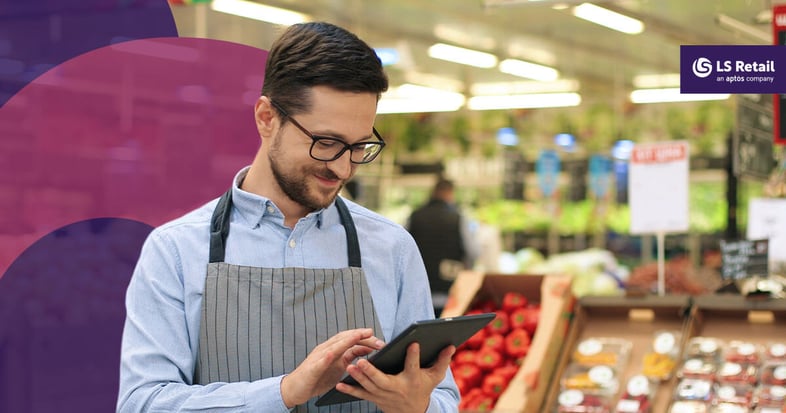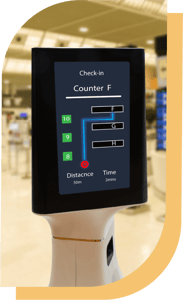
The grocery industry is leading the way in providing exceptional customer experiences within the retail sector. As the industry faces new challenges like online shopping and pre-ordering, grocers are embracing transformation and innovation with the help of technology.
Let's explore some of the most innovative ways that grocery retailers are revolutionizing their trade, and discover ideas that you can borrow to enhance your own business.
1. Eliminate checkout with grab-and-go concepts

The introduction of Amazon's automated and checkout-free Go convenience stores caused quite a stir. These innovative stores utilize cutting-edge machine learning and sensor technology, allowing customers to simply walk in, select their items, and be automatically charged when they leave. Since the successful launch of this concept, various grocers have followed suit with similar cashierless formats, including using self checkout system like ScanPayGo.
Dutch grocery chain Albert Heijn has also embraced the trend by testing small-scale cashierless stores. These compact installations, resembling shipping containers, are accessible 24/7 and can be entered using a credit or debit card. Cameras strategically placed throughout the store capture the shopper's movements, while weight sensors detect the items they select. Upon leaving, customers can either verify their receipt or choose to be automatically charged within milliseconds.
In Brazil, Zaitt convenience stores offer a unique payment method using facial recognition technology. By utilizing Radio Frequency Identification (RFID), these stores are able to detect the items customers have picked up. To complete the transaction, customers must verify their purchases on a screen, after which the payment is deducted from their account. The doors then open, allowing them to exit hassle-free.
Just by removing the cash register, grocers have eliminated the transactional part of the shopping experience, and transformed the entire customer journey. Imagine exporting the same concept to your stores. How could you make the buying experience simpler? What could you change to enhance the experience and eliminate the transactional parts?
2. Bridge the offline and online experience
 As consumer expectations evolve, brick-and-mortar stores are under pressure to offer the same level of convenience and access to information as online shopping. The grocery industry has embraced this challenge and is at the forefront of providing customers with the online features they crave in a physical store setting.
As consumer expectations evolve, brick-and-mortar stores are under pressure to offer the same level of convenience and access to information as online shopping. The grocery industry has embraced this challenge and is at the forefront of providing customers with the online features they crave in a physical store setting.
Chinese e-commerce company JD.com opened a physical grocery chain called 7Fresh that merges the worlds of online and offline in an experience they call “Boundaryless Retail.” Shoppers can use the branded app in the store to scan the barcodes of each item on sale and see product information, including details such as country of origin and nutritional value. The app can even suggest recipes that use the ingredients being browsed. This easy access to information pushes the world of brick-and-mortar closer to the world of e-commerce, where product info is always one click away.
Shoppers’ desire to be more informed about their purchases extends well beyond food retail. Are these shoes made of leather? Is this wardrobe made of sustainable wood? Which kind of charger works with this computer? These are just some of the questions your customers have when shopping in-store. The more you empower your customers to make informed decisions, the easier it will be for them to take the step to buy.
3. Enable voice ordering
 Voice-activated shopping is one of the most innovative technologies that are on the rise in the grocery space. Amazon and Google, two of the largest developers of voice-control devices, have each partnered with grocery chains to develop this new way of shopping.
Voice-activated shopping is one of the most innovative technologies that are on the rise in the grocery space. Amazon and Google, two of the largest developers of voice-control devices, have each partnered with grocery chains to develop this new way of shopping.
Amazon is using its digital assistant Alexa to enable US-based Amazon Prime members to shop at its grocery chain Whole Foods, while shoppers at Carrefour supermarkets in France can connect through Google smart speakers and mobile devices. Customers assemble their grocery orders by simply saying what they need, such as “Camembert.” With the increasing accuracy and customization that comes from machine learning and artificial intelligence (AI) powered analysis of data from previous orders, the system will know exactly which brand of cheese you prefer. Shoppers can then choose to collect their shopping at their local store, or to have it delivered right to their door.
While most customers are still not ready for voice-activated shopping, the pool of users is steadily growing. As hands-free shopping becomes more commonplace, make sure you can support these new ways of shopping, with an eCommerce website designed for voice commands and support for the most popular voice assistants.
4. Find alternative revenue streams
 Retailers have long been relying on revenue sources unrelated to core products. We have seen stores sub-letting space to coffee shops and restaurants for years, and grocery has been no exception. But as grocers deal with the increasing pressure of market competition from larger brands, they’re increasingly turning to unconventional alternative revenue streams to compensate.
Retailers have long been relying on revenue sources unrelated to core products. We have seen stores sub-letting space to coffee shops and restaurants for years, and grocery has been no exception. But as grocers deal with the increasing pressure of market competition from larger brands, they’re increasingly turning to unconventional alternative revenue streams to compensate.
U.S. grocery chain Kroger is investing in new areas of business such as Kroger Health, a wellness and nutrition branch built on their in-store and subsidiary pharmacy chains. They have begun introducing free health screening kiosks and in-person consultations for customers, while also partnering with local primary care clinic networks to provide low- to no-cost healthcare for their employees. This investment opens a new source of revenue, but also provides wellness care for employees that can generate savings for the employer in the long run.
Customers can also take advantage of Kroger Personal Finance, which includes credit cards, check cashing, identity theft protection, and partnerships with home mortgage lenders. This initiative to expand grocery’s reach has so far been successful in out-performing targeted goals and will likely continue to grow.
Some non-food retailers are already taking note of these opportunities. Electronics chain Best Buy recently announced their own entry into the health care market, while Japanese retailer Muji has just opened three hotels where guests use the brand’s minimalist houseware products as a part of their stay. In the UAE, aswaaq also manages real estate developments. Is your business currently considering its options?
5. Automate tasks with robots
 Grocery stores are giving other retailers and consumers a look at another merchandising revolution that is just beginning to unfold. U.S. grocery retailers Walmart and Albertsons have both recently begun using robots in several stores to perform low-level tasks previously done by human employees
Grocery stores are giving other retailers and consumers a look at another merchandising revolution that is just beginning to unfold. U.S. grocery retailers Walmart and Albertsons have both recently begun using robots in several stores to perform low-level tasks previously done by human employees
These machines can mop floors, unload trucks, scan boxes, keep track of inventory, and pick items to speed up online orders. The shelf-scanning models use AI in the cloud to analyze data gathered through the machines’ 3D cameras, and understand what’s on the shelves and what needs to be restocked. The automated inventory sorting system then takes this information and prioritizes what needs to be stocked as it sorts new deliveries from the distribution center. The result is higher operational efficiency, and as robots keep the store in its best shape for customers, employees are free to focus on creating positive customer experiences and delivering information and personalized advice.
Non-grocery retailers have already begun implementing robotics technology into their warehouses. Swedish shirtmaker Eton has recently automated its facilities for robotic inventory and order fulfilment, making a better use of its space and increasing productivity. E-commerce giants like Alibaba and Flipkart have maximized the efficiency of their massive distribution centers with hundreds of tireless robots. How could your business benefit from greater automation?
Grocery is a competitive, complex industry. Perhaps because of that, supermarkets are used to taking risks. In recent years, these risks are paying off, and the most daring grocers are finding success in trying out innovative ideas to improve their business.
Why shouldn’t the same be true for the rest of retail?
Even if there are many ways to be an innovator, there is a general formula many successful businesses follow when experimenting with new concepts.
- They look at what businesses in adjacent industries are doing to simplify their business and delight their customers – and try to apply these ideas to their own industry.
- They track their customers’ journey, and create a value proposition that will simplify their life.
- They don’t add new technology just because it exists. Rather, they analyze the solutions available, and implement the ones that suit the business and its goals.
- They dare to try something new. So what if none of your competitors have done it before?
- They’re ready for change, and always keep an eye open toward scaling up to the business they want to be.
The steps may seem straightforward, but the journey to becoming an innovative business (especially a successful one!) can be tough. Do you need help to get there? Contact us: our retail experts can suggest you what technology you need to achieve your business goals.

